Vibha Mahendra

The human lens is made up of two types of cells: a monolayer of lens epithelial cells, and its differentiated progeny, lens fiber cells. The differentiation process is a complex sequence of events in which lens epithelial cells slowly lose all their organelles, and elongate into lens fiber cells. There is a lens membrane protein called Lim2 that appears to exist only in lens fiber cells, and not in lens epithelial cells. Lim2 is known to be critically important for maintaining the integrity of the lens, and its role will […]
Lisa Wong

This summer, the aim of my project is to investigate the origin of drug resistance in hospital acquired, multi-drug resistant bacteria. This project challenges the idea that human overuse of antibiotics is dominant in selecting for drug resistance in bacteria, and instead investigates the role of food as the primary source of new drug resistance for bacteria in our body. This is a particularly dangerous and has wide public health implications because of the ability for pathogenic bacteria in hospitals to rapidly acquire new drug resistances. Bacteria can harbor drug […]
Sharyn Hall

Habitus is the acquired expression of personal taste in art, dialect, comportment, zip code, literature, entertainment, etc. established by the wealthy (unconsciously) as a means to set themselves apart from the working class. Yet mere expression of habitus by the lower economic strata changes their social class (Bourdieu, 1976). The Protestant Work Ethic (PWE) is best captured by the colloquialism pull yourself up by your bootstraps and is the belief that anyone can achieve wealth and success if s/he is willing to do the hard work. Notwithstanding, the social cues […]
Shila Manandhar
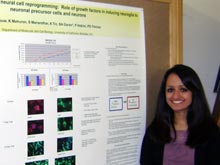
Neurogenesis, the process by which new neurons form, was thought to be impossible in mature brains for most of the 20th century. However, recent studies have found that neurogenesis in intact adult brains does occur in specific regions. I will be studying neurogenesis in vitro using neuroglial cells, which are neuron supporting cells, by treating them with Epidermal Growth Factor (EGF) and Fibroblast Growth Factor (FGF). Following treatment, I will perform functional tests to evaluate the extent to which these factors were able to promote the transdifferentiation of these neuroglial […]
Wing Shing Yip
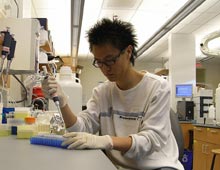
T. thermophilus RNase H (TthRNase H) is a protein that is stable at high temperatures. In my project, I will examine how the amino acid sequence of TthRNase H determines its folding properties that lead to its thermostability. To approach this question, I am going to construct two proteins, one containing the core of C. tepidum RNase H (a protein stable at moderate temperatures) and the periphery of TthRNase H and another containing the core of C. tepidum RNase H and the the periphery of E. coli RNase H (a […]
Itamar Haritan

I am interested in the personal and political transformations that occur at the beginning and throughout the process of mobilization for social change. In particular, I am interested in the activities of the Jerusalem Open House, a grassroots organization that is the politically active community center of the LGTBQ community in Jerusalem, a city deeply divided along various lines where even close daily contact does not translate into mutual understanding between different communities. By volunteering and interviewing individuals in the Open House, I hope to understand the personal-political transformations that […]
Matthew McElroy
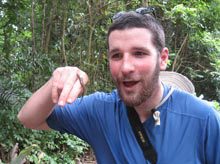
I am interested in the thermal ecology of two tropical skinks, Emoia cyanura and E. impar, in Tahiti, French Polynesia. Since these skinks are so similar in morphology and ecology, they likely compete for essential resources, including sources of heat. So far, through field observations and lab experiments, I have found that E. cyanura prefers open canopy habitats and warmer body temperature relative to E. impar. To expand my study, I will test sprint speed of each species at different body temperatures to see if they are thermal “generalists” or […]
Lauren Zerbib

The basis of sexual reproduction is a perennial topic of interest in evolutionary biology. The rotifer, Brachionus Calyciflorus, is an interesting system to compare sexual and asexual reproduction because it is cyclically parthenogenetic, meaning it alternates between generations produced sexually and asexually. By understanding the mechanisms controlling the timing of sexual reproduction in such organisms, we can better understand how natural selection determines the balance between asexual and sexual reproduction. In this study I look at the contributions of three related factors in determining the proportion of sexually reproducing daughters […]
Jenny Hua
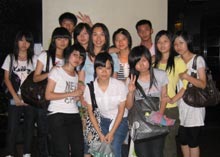
With the amazing economic transformations China has shown the world in the past several decades comes an expectation for the country to show signs of also transforming politically. What is the ideological glue that holds the country together after the obsolescence of Marxist-Leninism and Maoist thought? Nationalism seems to be the new official religion of China. Through participant observation in a few Shenzhen high schools, I want to see how nationalism is conceptualized and combined with morality specifically within the Chinese education system. I hope to observe the effect that […]
Jane O
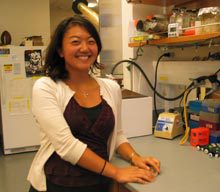
Because any given cell carries an overwhelming excess of genetic information, they need a way to selectively pinpoint what they need, when they need it. Silencing entire regions of the genome via chromatin modifications is one method that eukaryotes have developed to great effect. The four SIR (Silent Information Regulator) genes are absolutely critical to silencing in yeast. Wild-type Sir3 typically requires Sir2s deacetylation activity, and not just the deacetylation itself, in a mechanism that is still unclear. I will use sequencing and protein structural analysis to study PCR generated […]